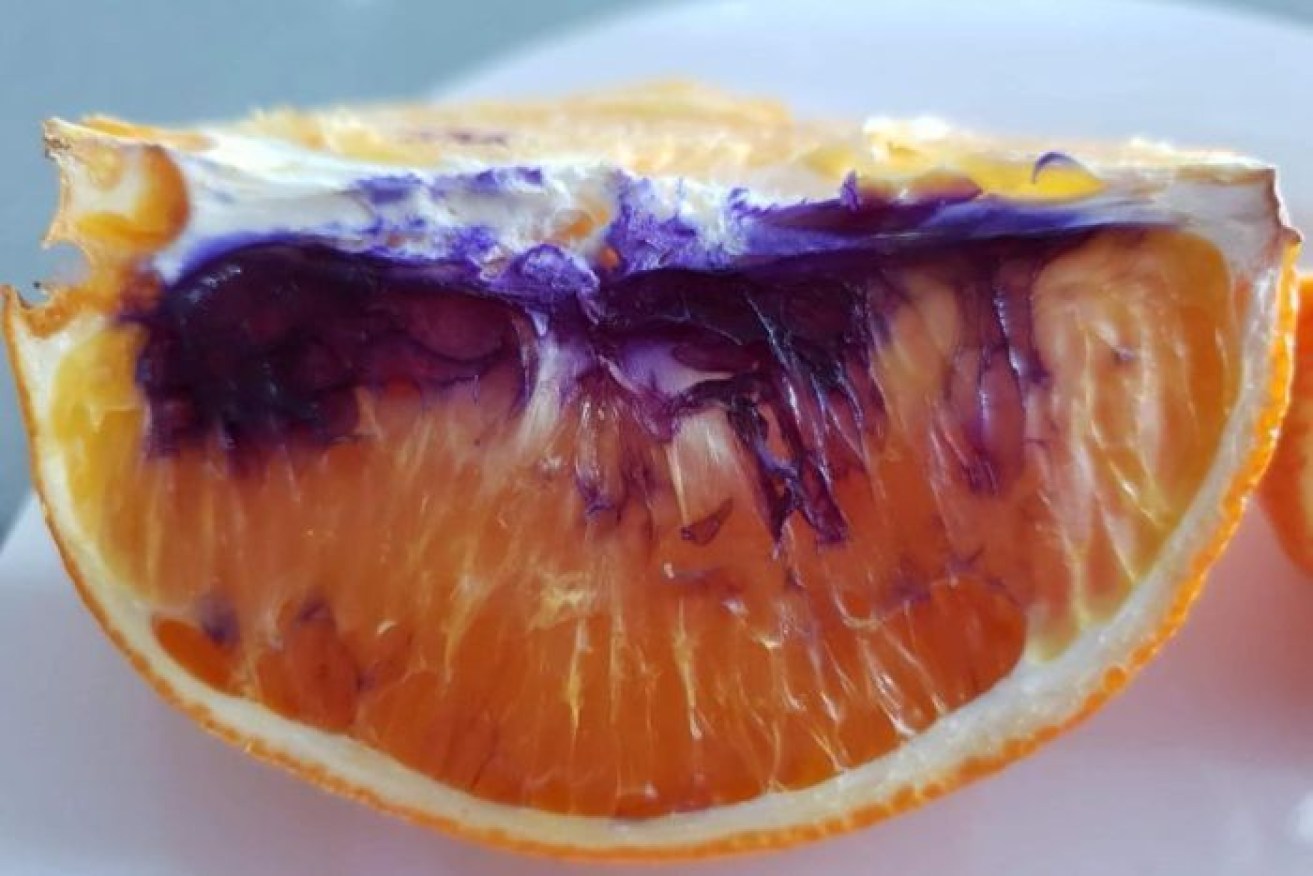Scientists now know why this orange turned purple out of the blue

This orange went purple hours after it was cut up at Neti Moffit's home. Photo: Neti Moffitt
Scientists finally know why an orange purchased from a fruit and veg shop in suburban Brisbane turned purple, hours after it was cut open.
The answer? Naturally occurring anthocyanins in the orange reacted with the iron particles found on the recently sharpened knife used to cut it, causing it to go purple.
Scientists with the Queensland government collected samples of oranges from Neti Moffitt’s house after the scraps and leftover changed colour earlier this month.
They also took the knife used to cut them, as well as the steel used to sharpen it.
They were tested at Queensland Health’s Forensic and Scientific Services (FSS) laboratory at Coopers Plains on Brisbane’s south side.
On Tuesday, the long-awaited results were released to ABC News.
“The results of analysis have confirmed the discolouration was caused by the reaction of anthocyanins, a pigment that is naturally present in oranges, and traces of iron and/or other metals from a freshly sharpened knife,” it said.
“These pigments are not known to represent any risk to human health.”

Ms Moffitt’s son ate pieces of the orange before it turned purple. Photo: Neti Moffitt
Mystery solved following numerous tests
Queensland chief chemist Stewart Carswell said numerous tests were carried out to find out why the oranges had turned purple.
“We put the orange through a variety of chemical and instrumental tests including simple chemical spot tests, liquid chromatography high-resolution mass spectrometer, inductively coupled plasma mass spectrometry, and UV-Visible spectrophotometry looking for metals, natural and artificial colours and pigments, pesticides and other contaminants,” Mr Carswell said.
“It was exciting to be able to see a natural part of the orange, anthocyanins which are antioxidants that play a vital role in protecting our bodies, also played a part in the results.”
Mr Carswell said the kind of analysis was very different to the thousands of samples FSS received each week.
“We see samples that range from blood, urine, water, soil, fish and foodstuffs. So to have an orange come through was really different for our team,” he said.

Scientists took the oranges away for testing earlier this month. Photo: Neti Moffitt
Ms Moffitt said to learn her purple orange was a rare natural occurrence came as a pleasant surprise.
“Amazement, I think is the main thing I’m feeling at the moment, that this has happened, and it’s still so rare,” she said.

Ms Moffitt with her two children.
“I’m glad we could find an answer, that would’ve been a real head-scratcher otherwise.”
Ms Moffitt said her husband had sharpened the knife “a night or two” before it was used to cut the orange.
“That knife would’ve been cleaned many times over, but it just goes to show just the slightest change of environment or whatever that is can have such an amazing effect,” she said.
“It was a matter of having all of our ducks lined up in a row for this to occur.”
Queensland Health notified Ms Moffitt of the results, and returned her knife and sharpener.

Ms Moffitt’s knife and sharpener were returned to her on Tuesday. Photo: Neti Moffitt
Your purple orange theories
Theories and speculation ran wild after ABC published the story of the purple orange discovery earlier this month. Here are a few of them:
Pete: “Possibly Vanadium oxidising, which could be present in the knife blade if a low-alloy steel knife was used to cut the fruit.”
Dean: “The anthocyanins in the orange are reacting with metal ions to form ferric anthocyanin, which is a blue pigment. Harmless, but colourful, The metal ions could be from sources such as a knife, benchtop, etc.”
Mark: “This looked like the sort of colouration that would appear on axes after cutting fresh hardwood timbers. It’s caused by the tannins (acid in the sap) reacting with the steel/iron in the blade – some sort of chemical chelate formation. The colour would appear on both the blade and on the wood surface. I don’t know if it’s the same thing, but that’s what first occurred to me. The fact that it doesn’t happen every time an orange is cut might mean that oranges produce the acids in varying concentrations. Of course, it might have nothing to do with it either!”
Ron: “The purple in this orange is quite likely to be Prussian Blue (iron hexacyanoferrate), a compound formed by the oxidation of ferrous ferrocyanide salts. Cyanide salts were formerly used in steel heat treatment and hardening processes (“case hardening”), and may still be used in some places such as China. The acids in the orange, such as citric acid and ascorbic acid, will likely have been the precipitators of a chemical reaction between the steel knife used to cut the orange, and the orange itself. There is possibly some residual cyanide salts diffused through the metal of the knife used to cut the orange – due to poor post-steel treatment processes, or hurried processes.“
Mike: “Potassium permanganate is my view, not an uncommon household chemical. Especially in farming communities.”
Stefan: “I don’t know why this is ‘baffling’ to the experts. It is a caused by a fungus that has found its way into the orange at some stage. Sometimes these fungi can produce mycotoxins. I saw the same thing in Gove, on a potato.“
Ian: “Could it possibly be an iron ammonium citrate compound?”
Michael: “Hasn’t Queensland got a diverse range of lichen? Some of that could have acted as litmus, turning the citric acid purple. It’s possibly a reaction with litmus spores, or perhaps traces of chemicals within the kitchen.”








